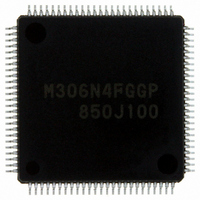M306N4FGGP#U3 Renesas Electronics America, M306N4FGGP#U3 Datasheet - Page 250

M306N4FGGP#U3
Manufacturer Part Number
M306N4FGGP#U3
Description
IC M16C/6N4 MCU FLASH 100-LQFP
Manufacturer
Renesas Electronics America
Series
M16C™ M16C/6Nr
Specifications of M306N4FGGP#U3
Core Processor
M16C/60
Core Size
16-Bit
Speed
24MHz
Connectivity
CAN, I²C, IEBus, SIO, UART/USART
Peripherals
DMA, WDT
Number Of I /o
85
Program Memory Size
256KB (256K x 8)
Program Memory Type
FLASH
Ram Size
10K x 8
Voltage - Supply (vcc/vdd)
3 V ~ 5.5 V
Data Converters
A/D 26x10b; D/A 2x8b
Oscillator Type
Internal
Operating Temperature
-40°C ~ 85°C
Package / Case
100-LQFP
Package
100LQFP
Family Name
M16C
Maximum Speed
24 MHz
Operating Supply Voltage
3.3|5 V
Data Bus Width
16|32 Bit
Number Of Programmable I/os
87
Interface Type
I2C/UART
On-chip Adc
26-chx10-bit
On-chip Dac
2-chx8-bit
Number Of Timers
11
For Use With
R0K3306NKS001BE - KIT DEV RSK RSK-M16C/6NKR0K3306NKS000BE - KIT DEV RSK RSK-M16C/6NK
Lead Free Status / RoHS Status
Lead free / RoHS Compliant
Eeprom Size
-
Available stocks
Company
Part Number
Manufacturer
Quantity
Price
- Current page: 250 of 414
- Download datasheet (3Mb)
M16C/6N Group (M16C/6N4)
Rev.2.40
REJ09B0009-0240
Figure 19.13 Sub Modes of CAN Operation Mode
19.5.2 CAN Operation Mode
19.5.3 CAN Sleep Mode
19.5.4 CAN Interface Sleep Mode
CAN operation mode is activated by setting the Reset bit in the CiCTLR register (i = 0, 1) to 0. If the Reset
bit is set to 0, check that the State_Reset bit in the CiSTR register is set to 0.
If 11 consecutive recessive bits are detected after entering CAN operation mode, the module initiates the
following functions:
Within CAN operation mode, the module may be in three different sub modes, depending on which type
of communication functions are performed:
Figure 19.13 shows the Sub Modes of CAN Operation Mode.
CAN sleep mode is activated by setting the Sleep bit to 1 in the CiCTLR register. It should never be
activated from CAN operation mode but only via CAN reset/initialization mode.
Entering CAN sleep mode instantly stops the clock supply to the module and thereby reduces power
dissipation.
CAN interface sleep mode is activated by setting the CCLK3 or CCLK7 bit in the CCLKR register to 1. It
should never be activated but only via CAN sleep mode.
Entering CAN interface sleep mode instantly stops the clock supply to the CPU Interface in the module and
thereby reduces power dissipation.
• The module's communication functions are released and it becomes an active node on the network
• Release the internal fault confinement logic including receive and transmit error counters. The module
• Module idle
• Module receives : The module receives a CAN message sent by another node.
• Module transmits : The module transmits a CAN message. The module may receive its own message
and may transmit and receive CAN messages.
may leave CAN operation mode depending on the error counts.
Apr 14, 2006
page 226 of 376
: The modules receive and transmit sections are inactive.
transmission
simultaneously when the LoopBack bit in the CiCTLR register = 1 (Loop back mode
enabled).
TrmState, RecState: Bits in CiSTR register (i = 0, 1)
Start
Module transmits
TrmState = 1
RecState = 0
transmission
Finish
Lost in arbitration
Module idle
TrmState = 0
RecState = 0
Finish
reception
Module receives
TrmState = 0
RecState = 1
Detect
an SOF
19. CAN Module
Related parts for M306N4FGGP#U3
Image
Part Number
Description
Manufacturer
Datasheet
Request
R

Part Number:
Description:
KIT STARTER FOR M16C/29
Manufacturer:
Renesas Electronics America
Datasheet:

Part Number:
Description:
KIT STARTER FOR R8C/2D
Manufacturer:
Renesas Electronics America
Datasheet:

Part Number:
Description:
R0K33062P STARTER KIT
Manufacturer:
Renesas Electronics America
Datasheet:

Part Number:
Description:
KIT STARTER FOR R8C/23 E8A
Manufacturer:
Renesas Electronics America
Datasheet:

Part Number:
Description:
KIT STARTER FOR R8C/25
Manufacturer:
Renesas Electronics America
Datasheet:

Part Number:
Description:
KIT STARTER H8S2456 SHARPE DSPLY
Manufacturer:
Renesas Electronics America
Datasheet:

Part Number:
Description:
KIT STARTER FOR R8C38C
Manufacturer:
Renesas Electronics America
Datasheet:

Part Number:
Description:
KIT STARTER FOR R8C35C
Manufacturer:
Renesas Electronics America
Datasheet:

Part Number:
Description:
KIT STARTER FOR R8CL3AC+LCD APPS
Manufacturer:
Renesas Electronics America
Datasheet:

Part Number:
Description:
KIT STARTER FOR RX610
Manufacturer:
Renesas Electronics America
Datasheet:

Part Number:
Description:
KIT STARTER FOR R32C/118
Manufacturer:
Renesas Electronics America
Datasheet:

Part Number:
Description:
KIT DEV RSK-R8C/26-29
Manufacturer:
Renesas Electronics America
Datasheet:

Part Number:
Description:
KIT STARTER FOR SH7124
Manufacturer:
Renesas Electronics America
Datasheet:

Part Number:
Description:
KIT STARTER FOR H8SX/1622
Manufacturer:
Renesas Electronics America
Datasheet:

Part Number:
Description:
KIT DEV FOR SH7203
Manufacturer:
Renesas Electronics America
Datasheet:











